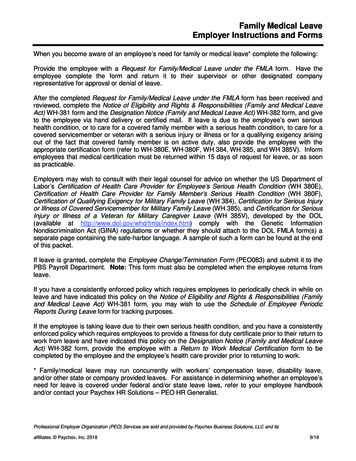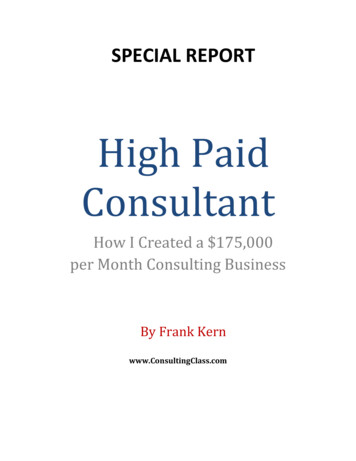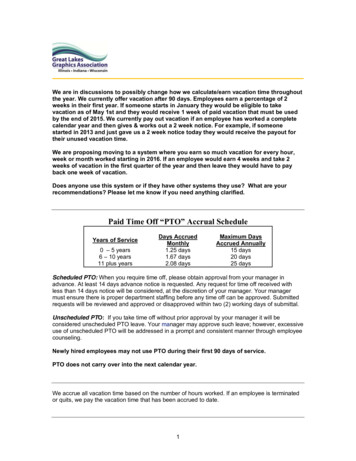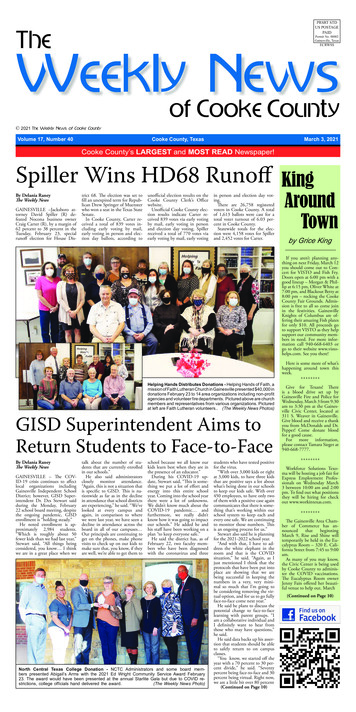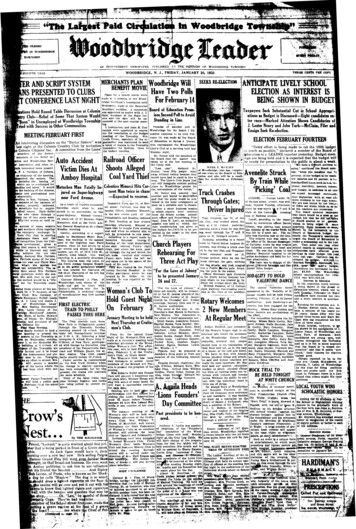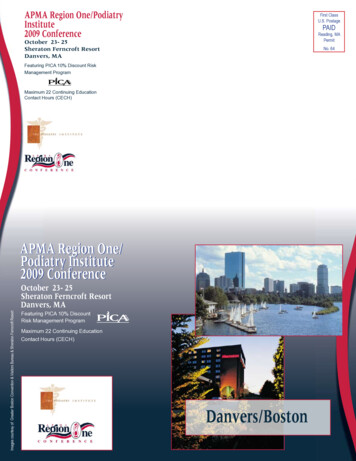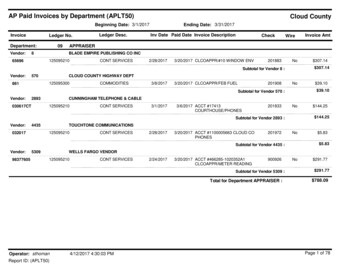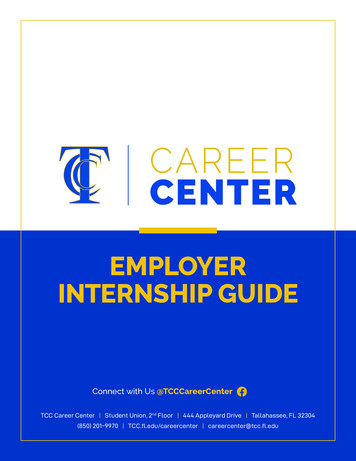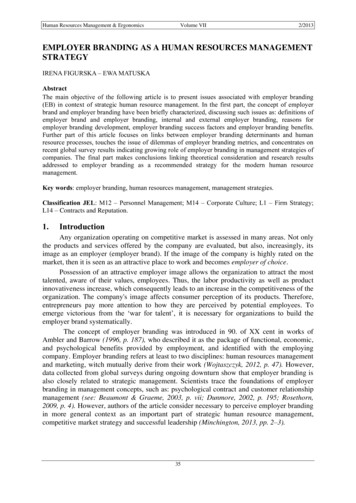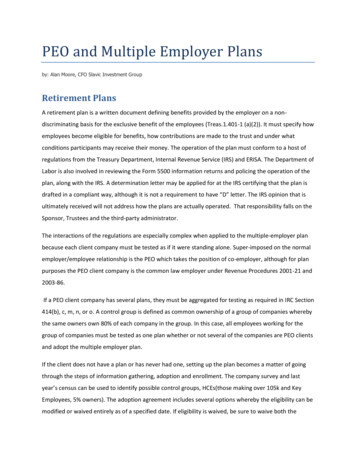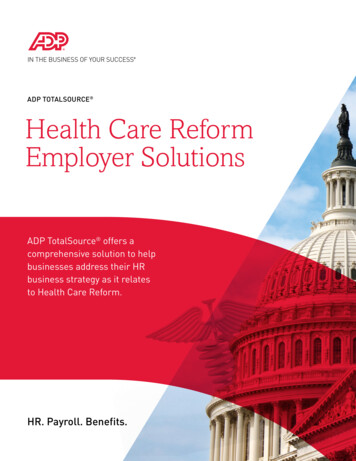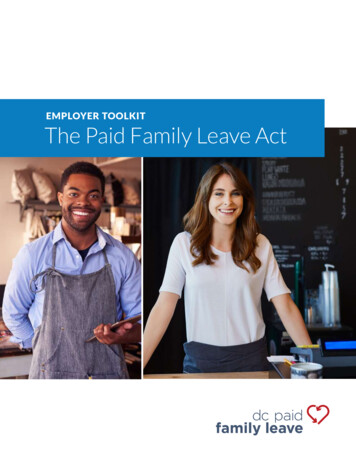
Transcription
EMPLOYER TOOLKITThe Paid Family Leave Act
About Paid Family LeaveDISCLAIMERDisclaimerThe Department of Employment Services (DOES) has provided this toolkit as a public service.It is designed to provide employers with an overview of their rights and responsibilities underthe District of Columbia’s Paid Family Leave (PFL) Program. It is intended as general informationonly and does not carry the force of a legal opinion. Liability and eligibility determinations will bemade on a case by case basis. DOES reserves the right to update the material and informationas necessary. The Universal Paid Leave Amendment Act (UPLA) of 2016 and related regulationsremain the official sources for information related to the PFL program.About DOESMission StatementThe Department of Employment Services (DOES) mission is to connectDistrict residents, job seekers, and employers to opportunities andresources that empower fair, safe, effective working communities.VisionThe Department of Employment Services provides comprehensiveemployment services to ensure a competitive workforce, fullemployment, life-long learning, economic stability, and the highestquality of life for all District residents.Connect With UsDEPARTMENT OF EMPLOYMENT SERVICES (DOES)Office of Paid Family Leave (OPFL)4058 Minnesota Avenue, NESuite 3700Washington, DC 20019Phone: (202) 899-3700Email: does.opfl@dc.govDCPaidFamilyLeave.dc.gov2"In the end,this levelsthe playingfield for smallbusinesses.Many of uswant to offerPaid FamilyLeave to ourworkers, butwe just can'tafford to do soon our own.-DC SMALLBUSINESS OWNER
KEY PFL INFORMATIONTop Things DC EmployersShould Know About PaidFamily LeaveREPORTING. Your business will be required to submit quarterly wage reports in a similarfashion to the UC30 wage report submitted for unemployment insurance taxes.RECORD KEEPING. You must keep payroll records for at least three years that includeeach worker’s name and Social Security number (or individual taxpayer identificationnumber), pay period dates, wages for each pay period, and dates of employment.BENEFITS DISTRIBUTION. Paid Family Leave benefit payments will be issued to eligibleindividuals directly from the Department of Employment Services.EMPLOYER EXEMPTION. The law does not provide any exemptions for employers.EMPLOYEE ELIGIBILITY. Part-time and full-time employees who work in DC are eligible.PROVISION OF BENEFITS. Employers can determine whether or not their sponsoredpaid leave benefits run concurrently with their workers’ use of the District’s Paid FamilyLeave program. However, an eligible individual’s right to the District’s Paid Family Leavebenefits shall not be diminished by an employer’s paid leave policy.UNEMPLOYMENT INSURANCE TAX RATE. Paid Family Leave contributions andunemployment insurance contributions are separate. Employers pay taxes based on theassociated rates for each program respectively.DEFINING REGULATIONS. DC is using public input in the development of proposedregulations for benefit rules.IMPLEMENTATION. Based on final regulations, the DC Department of EmploymentServices’ Office of Paid Family Leave will develop an infrastructure to manage the benefitfor employers and employees, and to ensure that employers and all stakeholders are partof the process.3
TABLE OF CONTENTS402Disclaimer03Top Things DC Employers Should Know05Introduction07Ch. 1: Covered Employers13Ch. 2: Self-Employed Individuals21Ch. 3: Covered Workers25Ch. 4: Reporting Wages and Paying Contributions29Ch. 5: Overview of Paid Leave and Benefits
INTRODUCTIONUnderstanding The Paid FamilyLeave ActEnacted in February 2017, the Universal Paid Leave Act of 2016 created the Paid FamilyLeave (PFL) program in the District. It provides self-employed individuals and workers ofcovered employers with:8 WEEKS6 WEEKS2 WEEKSparental leave to bondwith a new child, includingadopted and foster childrenfamily leave to care for asick family memberpersonal medical leaveThe purpose of this toolkit is to provide employers with an overview of the PFLprogram. It will also provide key information on employers’ responsibilities under theAct. As the program develops, further versions of this toolkit will be published on theOPFL website.All District of Columbia private sector employers must participate in this program, andalmost every DC worker will be eligible to receive benefits. The program is funded bycovered employers through a 0.62% payroll tax on covered worker wages. Coveredemployers include all DC employers subject to DC Unemployment Insurance (UI) taxand self-employed individuals who choose to opt in to the program. In general, coveredworkers include all workers who (predominately) work in DC and no more than 50% inanother jurisdiction.The PFL program is administered by the Office of Paid Family Leave (OPFL) within theDepartment of Employment Services (DOES). Workers will apply for PFL benefits, receivetheir eligibility determinations, and benefit awards from OPFL.Employers and workers will use an online portal to interact with OPFL and receiveinformation. Employers will use the portal to pay contributions and record worker wages.Workers will use it to file and monitor their benefit claims. Self-employed individuals willuse it for paying contributions, recording their income, and filing for benefits.5
INTRODUCTIONTax Collection DeadlineIn general, employers will use the same portal and reporting/filing schedule as they currently dofor District Unemployment Insurance (UI).Helpful LinksIf you have any questions about PFL or related business requirements,please visit the following links:Department of Employment Services: https://does.dc.govOffice of Paid Family Leave: https://dcpaidfamilyleave.dc.govOffice of Human Rights: https://ohr.dc.govDepartment of Consumer and Regulatory Affairs: https://dcra.dc.govOffice of Tax and Revenue: https://otr.cfo.dc.gov6
Chapter 1COVERED EMPLOYERS
Covered EmployersCHAPTER 1Which Employers are Covered Under the Law?Under the UPLA, a covered employer is anyone who controls the wages, hours, or working conditionsof a worker and is required to pay Unemployment Insurance (UI) tax in DC for its workers. It alsoincludes self-employed individuals who opt into the PFL program (See Chapter 2).A covered employer can be an individual, general contractor, subcontractor, association, corporation,business trust, or another group of persons. It doesn’t include the federal government, the DistrictGovernment, or any employer in the District that DC cannot tax under federal law or treaty.An employer may be a covered employer even if they are not directly controlling a worker if they areindirectly controlling a worker through an agent. For example, an employer may be a covered employerif they use a staffing or temp agency.Non-Profits may be considered a covered employer if they are required to pay UI tax in DC for theirworkers. This includes non-profits who choose to self-insure and reimburse instead of paying quarterlyUI taxes.Employers who are notcovered employers underthese rules don’t need totake any action in notifyingDOES that they are notliable for the program.What If I’m a New Business?New businesses must first register with the Department of Consumer and Regulatory Affairs (DCRA)and the Office of Tax and Revenue (OTR). Afterwards, DOES will issue a determination on UI liability.If an employer is subject to UI, then they will receive information on PFL liability and registration.Employers are required to alert DOES about ownership changes. Successor employers may need tore-register with DOES.8
Covered Employers have 4 MainResponsibilities:1. Register/Update their DOES account on the EmployerSelf-Service Portal (ESSP)2. Provide notice about PFL to their workers3. File reports and pay contributions4. Keep recordsHow Should Employers Provide TheirWorkers with Notice of PFL?CHAPTER 1What are EmployersRequired to Do?Employerswill needto complywith noticerequirementsno earlierthan January1, 2020.Covered employers must provide their workers with notice of thePFL program at 4 times:1. Always (physical poster)2. Annually to all workers (paper or electronic form)3. At the time of hiring (paper or electronic form)4. At the time PFL is needed by a worker (paper or electronic form)Covered employers must keep a physical poster (provided by DOES) ateach worksite in a conspicuous place where labor notices are customarilyposted. Employers must also send a poster to covered workers who workremotely or predominately telework so that they can hang the postersat their individual worksites. Posters will be available on the DOES andOPFL websites for employers to print in standard sizes and display attheir worksites.For PFL, a worksite is a location where business is conducted or whereservices or industrial operations are performed. Some businesses maybe required to post multiple posters in the same physical building. Forexample, if a company has several departments on multiple floors withseparate break areas, then the company likely will need posters for eachseparate department’s common space.If an employer’s business activities result in workers working at manydifference places throughout the region, then the notice must be postedin the District location where workers report every day. For example, aplumbing company’s workers may spend their time at customers’ homes,but each morning the workers are required to check in at the office fortheir assignments. In this case, the poster should be in that central area ofthe office, even if workers are only there once a day.COMPLIANCECHECKCookie Co. hangstheir PFL poster in thebreak room with otheremployment law posters.Urban Farms keeps theirPFL poster in the roomwhere workers receivetheir work assignmentsevery morning and storetheir belongings for theday.Johnson, Smith, & Jones,has multiple locations inthe District, so they onlypost a notice in theirheadquarters.Employers are requiredto post a notice at eachworksite.9
CHAPTER 1If a covered worker becomesa non-covered worker for anyreason, then the employer isrequired to notify the workerof the loss of PFL eligibility.Notice Requirements ContinuedIn addition to always displaying the poster, coveredemployers must also annually provide their workers withthe PFL notice. While the poster must be in a physicalformat, the annual notice may be sent out by electronicor digital means. For instance, a company with severalhundred workers can choose to send an annual email toremind their workers of their PFL rights.Covered employers must also provide notice to newworkers within 30 days of hiring. This notice can alsobe in the form of an email or similar means. Somecompanies may find it easier to include it in paper formas part of their new-hire packet. Others may prefer toinclude it as part of their online onboarding process.Lastly, an employer must provide the PFL noticewhenever they are aware leave is needed. Employersare aware leave is needed when they receive directnotice from an employee that PFL leave may benecessary. This notice doesn’t need to be a formalrequest or even in writing. Employees also don’tneed to be aware that their leave event qualifies forPFL or even know if they will take time off work yet.Therefore, it is important for employers to know whatmay be a qualifying PFL leave event so that employeesare well informed of their options. If an employee isunable to give direct notice because of an emergency,then a family member, coworker, or another personmay provide direct notice. It will be considereddirect notice from the employee if it is clear that theemployee intends, or would intend, for their employerto know about the leave event.10For this type of notice, who an employer and anemployee are may vary depending on the situation.An employer is anyone an employee believes hassupervisory power. For example, a restaurant workermay tell their shift manager without realizing there isa formal HR office they should contact.In this case, it is still the shift manager’sresponsibility to provide the notice or direct theemployee to the correct person.If an employee is unable to give direct notice becauseof an emergency, then a family member, coworker,or another person may provide direct notice. It willbe considered direct notice from the employee if it isclear that the employee intends, or would intend, fortheir employer to know about the leave event.COMPLIANCE CHECKAlex receives a call that a family member was ina car accident. Before running out the door, Alextells her coworker, Brian, to tell their manager.The manager is unsure if Alex will file for PFLleave or even if the event qualifies. He decides toemail Alex the PFL notice just in case.Benjamin doesn’t show up to work onemorning and does not return his manager’scalls. The next day, a family member contactshis job to let them know he is hospitalized.His manager doesn’t take any steps to giveBenjamin or his family the PFL notice.Although Benjamin didn’t tell his managerhimself, his manager should consider this directnotice from Benjamin.Desha comes to work late after a doctor’sappointment. Her supervisor asks how it wentand Desha responds that her doctor advisedher to get major surgery. Her supervisordoesn’t give her the PFL notice.Even though Desha didn’t specifically requestleave from work, her supervisor received directnotice from Desha that she will likely need leavefrom work for a PFL event.
CHAPTER 1How Do Employers ProveNotice?Employers have the burden of proving compliance with the PFL notice requirements.Violations of the notice requirements may result in a civil penalty of: 100 for each covered worker who didn’t receive individual notice; and/or 100 for each day that a covered employer failed to post the notice in aconspicuous place at each worksite.Covered employers can establish compliance for providing individual notice to their workersby showing email receipts or signed statements from their workers acknowledging delivery.The
employee intends, or would intend, for their employer to know about the leave event. For this type of notice, who an employer and an employee are may vary depending on the situation. An employer is anyone an employee believes has supervisory power. For example, a restaurant worker may tell their shift manager without realizing there is a formal HR office they should contact. If a covered .
